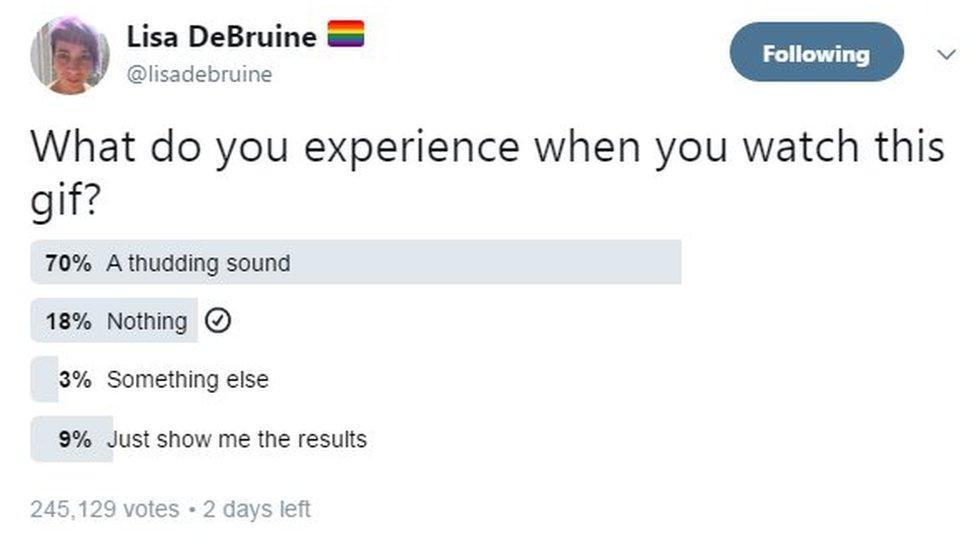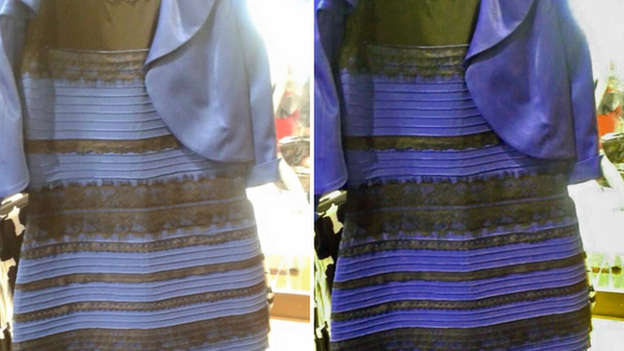Why some people can hear this silent gif
- Published
Allow X content?
This article contains content provided by X. We ask for your permission before anything is loaded, as they may be using cookies and other technologies. You may want to read X’s cookie policy, external and privacy policy, external before accepting. To view this content choose ‘accept and continue’.
Can you hear this gif?
Remember the white and gold dress that some internet users were certain was actually blue and black? Well, this time the dilemma being discussed online is whether you can hear anything in a silent animation of skipping pylons.
Some people claim they can hear a thudding sound when the pylon hits the ground and the picture vibrates.

The gif was created by @IamHappyToast in 2008
The gif was created in 2008 by @IamHappyToast , externalas part of a photoshop challenge on the boards of b3ta.com and has been circulating online since then - such as on Reddit's r/noisygifs subreddit in 2013, external.
Many social media users have discussed the noisy-gif phenomenon, as on Imgur in 2011, external, for example, where it was titled an "optical illusion for the ears".
It resurfaced again last weekend when Dr Lisa DeBruine from the Institute of Neuroscience & Psychology at the University of Glasgow posted it on Twitter, asking her followers to describe whether they experienced any auditory sensations, external while watching it.

Dr DeBruine received more then 245,000 responses from people claiming to hear a sound accompanying the animation, with 70 per cent of respondents saying they could hear a thudding sound.
Allow X content?
This article contains content provided by X. We ask for your permission before anything is loaded, as they may be using cookies and other technologies. You may want to read X’s cookie policy, external and privacy policy, external before accepting. To view this content choose ‘accept and continue’.
One person who suffers from ringing ears replied, external: "I hear a vibrating thudding sound, and it also cuts out my tinnitus during the camera shake." Others offered explanations as to why, external.
While another suggested, external it may have something to do with correlated neuronal activity: "The brain is 'expecting/predicting' what is coming visually and then fires a version of what it expects across the relevant senses. Also explains why some might 'feel' a physical shake."
"My gut says the camera shake is responsible for the entire effect. Anything that shook the camera like that, would probably make the 'thud' sound," posted another Twitter user, external.
Which is also the explanation which appeals to the gif's creator.
Allow X content?
This article contains content provided by X. We ask for your permission before anything is loaded, as they may be using cookies and other technologies. You may want to read X’s cookie policy, external and privacy policy, external before accepting. To view this content choose ‘accept and continue’.
You may also like:
Dr DeBruine told the BBC: "I don't know why some people hear it very clearly, others only feel it, and others perceive nothing at all. Some deaf and hard of hearing people have reported all three perceptions, as have people with aphantasia," a lack of visual imagery.
"I thought some of the vision scientists I follow would be able to explain it right away, but it seems like there are several plausible explanations and no clear consensus."
The Twitter thread caught the attention of Chris Fassnidge, a doctoral candidate in psychology at London's City University. He has been carrying out research in this very field.
He suggested a possible theory which his lab call the "visual ear."

In synaesthesia, people's senses are jumbled up
"I suspect the noisy gif phenomenon is closely related to what we call the Visually-Evoked Auditory Response, or vEAR for short," explained Fassnidge.
"This is the ability of some people to hear moving objects even though they don't make a sound, which may be a subtle form of synaesthesia - the triggering of one sense by another.
"We are constantly surrounded by movements that make a sound, whether they are footsteps as people walk, lip movements while they talk, a ball bouncing in the playground, or the crash as we drop a glass. There is some evidence to suggest that synaesthetic pairings are, to some extent, learnt during infancy.
"I might assume I am hearing the footsteps of a person walking on the other side of the street, when really the sound exists only in my mind.
"So this may be a common phenomenon because the sound makes sense, but for that exact reason we may not even know we have this unusual ability until the noisy gif suddenly came along in the last few years.
"What determines who experiences vEAR and how intensely is probably individual differences in how our brain is wired."
By Rozina Sini, BBC's UGC and Social News Team
- Published16 March 2015

- Published6 November 2016

- Published26 August 2015

- Published20 November 2013

- Published12 December 2013
